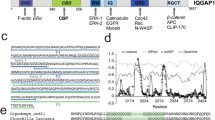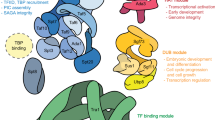Abstract
In an adenosine triphosphate (ATP)-dependent process, the hSWI/SNF chromatin remodeling complex functions to alter chromatin structure, thereby regulating transcription factor access to DNA. In addition to interactions with transcription factors and recognition of acetylated histone residues, the chromatin remodeling activity of hSWI/SNF has also been shown to respond to a variety of cell signaling pathways. Our results demonstrate a novel interaction between the serine/threonine kinase Akt and members of the hSWI/SNF chromatin remodeling complex. Activation of Akt in HeLa cells resulted in its association with hSWI/SNF subunits: INI1, BAF155 and BAF170, as well as actin. BAF155 became preferentially recognized by an antibody that detects phosphorylated Akt substrates upon activation of Akt, suggesting that BAF155 may be an in vivo target for phosphorylation by Akt. Glutathione-S-transferase (GST) pulldown experiments demonstrated that INI1 and BAF155 were both capable of directly interacting with Akt. Finally, in vitro kinase assays provided additional evidence that BAF155 and potentially INI1 are substrates for Akt phosphorylation. These data provide the first evidence that Akt signaling may modulate function of the hSWI/SNF complex.
This is a preview of subscription content, access via your institution
Access options
Subscribe to this journal
Receive 50 print issues and online access
$259.00 per year
only $5.18 per issue
Buy this article
- Purchase on Springer Link
- Instant access to full article PDF
Prices may be subject to local taxes which are calculated during checkout





Similar content being viewed by others
Accession codes
Abbreviations
- hSWI/SNF:
-
hSWI (switch)/SNF (sucrose non-fermenting)
- BRG1/hBrm:
-
Brahma-related gene 1/human Brahma
- BAF:
-
BRG1-associated factor
- INI1:
-
integrase interactor 1
- SMARCB1:
-
SWI/SNF-related matrix-associated actin-dependent regulator of chromatin B1
References
Agalioti T, Lomvardas S, Parekh B, Yie J, Maniatis T, Thanos D . (2000). Cell 103: 667–678.
Banine F, Bartlett C, Gunawardena R, Muchardt C, Yaniv M, Knudsen ES et al. (2005). Cancer Res 65: 3542–3547.
Belandia B, Orford RL, Hurst HC, Parker MG . (2002). EMBO J 21: 4094–4103.
Betz BL, Strobeck MW, Reisman DN, Knudsen ES, Weissman BE . (2002). Oncogene 21: 5193–5203.
Biegel J, Zhou J, Rorke L, Stenstrom C, Wainwright L, Fogelgren B . (1999). Cancer Res 59: 74–79.
Blom N, Sicheritz-Pontén T, Gupta R, Gammeltoft S, Brunak S . (2004). Proteomics 4: 1633–1649.
Chai J, Charboneau AL, Betz BL, Weissman BE . (2005). Cancer Res 65: 10192–10198.
Chen J, Archer TK . (2005). Mol Cell Biol 25: 9016–9027.
Cheng SW, Davies KP, Yung E, Beltran RJ, Yu J, Kalpana GV . (1999). Nat Genet 22: 102–105.
Craig E, Zhang Z-K, Davies KP, Kalpana G . (2002). EMBO J 21: 31–42.
Cui K, Tailor P, Liu H, Chen X, Ozato K, Zhao K . (2004). Mol Cell Biol 24: 4476–4486.
Datta SR, Dudek H, Tao X, Masters S, Fu H, Gotoh Y et al. (1997). Cell 91: 231–241.
DiRenzo J, Shang Y, Phelan M, Sif S, Myers M, Kingston R et al. (2000). Mol Cell Biol 20: 7541–7549.
Doan DN, Veal TM, Yan Z, Wang W, Jones SN, Imbalzano AN . (2004). Oncogene 23: 3462–3473.
Franke TF . (1999). Neural Notes V: 3–7.
Franke TF, Hornik CP, Segev L, Shostak GA, Sugimoto C . (2003). Oncogene 22: 8983–8998.
Fryer CJ, Archer TK . (1998). Nature 393: 88–91.
Gresh L, Bourachot B, Reimann A, Guigas B, Fiette L, Garbay S et al. (2005). EMBO J 24: 3313–3324.
Guidi CJ, Sands AT, Zambrowica BP, Turner TK, Demers DA, Webster W et al. (2001). Mol Cell Biol 21: 3598–3603.
Huang M, Qian F, Hu Y, Ang C, Li Z, Wen Z . (2002). Nat Cell Biol 4: 774–781.
Kadam S, Emerson BM . (2003). Mol Cell 11: 377–389.
Kang H, Cui K, Zhao K . (2004). Mol Cell Biol 24: 1188–1199.
Klochendler-Yeivin A, Fiette L, Barra J, Muchardt C, Babinet C, Yaniv M . (2000). EMBO Rep 1: 500–506.
Lawlor MA, Rotwein P . (2000). Mol Cell Biol 20: 8983–8995.
Lee D, Kim JW, Seo T, Hwang SG, Choi EJ, Choe J . (2002). J Biol Chem 277: 22330–22337.
Link KA, Burd CJ, Williams E, Marshall T, Rosson G, Henry E et al. (2005). Mol Cell Biol 25: 2200–2215.
Liu H, Kang H, Liu R, Chen X, Zhao K . (2002). Mol Cell Biol 22: 6471–6479.
Métivier R, Penot B, Hübner MR, Reid G, Brand H, Kos M et al. (2003). Cell 115: 751–763.
Miyauchi H, Minamino T, Tateno K, Kunieda T, Toko H, Komuro I . (2004). EMBO J 23: 212–220.
Morozov A, Yung E, Kalpana G . (1998). Proc Natl Acad Sci USA 95: 1120–1125.
Oruetxebarria I, Venturini F, Kekarainen T, Houweling A, Zuijderduijn LM, Mohd-Sarip A et al. (2004). J Biol Chem 279: 3807–3816.
Pattenden SG, Klose R, Karaskov E, Bremner R . (2002). EMBO J 21: 1978–1986.
Phelan M, Sif S, Narlikar G, Kingston RE . (1999). Mol Cell 3: 247–253.
Rando OJ, Zhao K, Janmey P, Crabtree GR . (2002). Proc Natl Acad Sci USA 99: 2824–2829.
Reincke BS, Rosson GB, Oswald BW, Wright CF . (2003). J Cell Physiol 194: 303–313.
Roberts CWM, Galusha SA, McMenamin ME, Fletcher CDM, Orkin SH . (2000). Proc Natl Acad Sci USA 97: 13796–13800.
Schönherr E, Levkau B, Schaefer L, Kresse H, Walsh K . (2001). J Biol Chem 276: 40687–40692.
Simone C, Forcales SV, Hill DA, Imbalzano AN, Latella L, Puri PL . (2004). Nat Genet 36: 738–743.
Versteege I, Medjkane S, Rouillard D, Delattre O . (2002). Oncogene 21: 6403–6412.
Versteege I, Seveenet N, Lange J, Rousseau-Merch M-F, Ambros P, Handgretinger R et al. (1998). Nature 394: 203–206.
Wang W, Cote J, Xue Y, Zhou S, Khavari P, Biggar S et al. (1996). EMBO J 15: 5370–5382.
Wu DY, Tkachuck DC, Roberson RS, Schubach WH . (2002). J Biol Chem 277: 27706–27715.
Xu W, Yuan X, Jung YJ, Yang Y, Basso A, Rosen N et al. (2003). Cancer Res 63: 7777–7784.
Zhang Z-K, Davies KP, Allen J, Ahu L, Pestell RG, Zagzag D et al. (2002). Mol Cell Biol 22: 5975–5988.
Zhao K, Wang W, Rando OJ, Xue Y, Swiderek K, Kuo A et al. (1998). Cell 95: 625–636.
Acknowledgements
We thank Drs Yusuf Hannun (MUSC) and Dennis Watson (MUSC) for critical review of this manuscript and Drs David Kurtz (MUSC), Robin Muise-Helmericks (MUSC), Dennis Watson and Daohong Zhou (MUSC) for helpful discussions and ideas. We additionally thank Dr Robin Muise-Helmericks for reagents and assistance with techniques, as well as Dr William Schubach (University of Washington) for the anti-INI1 antibody, and Dr Timothy Triche (Los Angeles Children's Hospital) for cell lines. Funding for this work was provided by the MUSC Department of Pathology and Laboratory Medicine (CFW, KSJF), Department of Defense grant #N00014-96-1298 (CFW, KSJF), a Hollings Cancer Center Abney Foundation Scholarship (KSJF), and National Institutes of Health grants #T32 DK007431-21 (WJM) and #T35 HL007769-14 (JSR). We also thank the MUSC Nucleic Acids Analysis and Molecular Biology Core Facilities.
Author information
Authors and Affiliations
Corresponding author
Rights and permissions
About this article
Cite this article
Foster, K., McCrary, W., Ross, J. et al. Members of the hSWI/SNF chromatin remodeling complex associate with and are phosphorylated by protein kinase B/Akt. Oncogene 25, 4605–4612 (2006). https://doi.org/10.1038/sj.onc.1209496
Received:
Revised:
Accepted:
Published:
Issue Date:
DOI: https://doi.org/10.1038/sj.onc.1209496
Keywords
This article is cited by
-
Stability of the PHF10 subunit of PBAF signature module is regulated by phosphorylation: role of β-TrCP
Scientific Reports (2017)
-
Peptide-induced bio-mineralization as a bio-mimetic means of detecting proteins in a mineralizing bio-context
Nano Research (2016)
-
Multi-tyrosine kinase inhibitors in preclinical studies for pediatric CNS AT/RT: Evidence for synergy with Topoisomerase-I inhibition
Cancer Cell International (2011)
-
The SWI/SNF complex and cancer
Oncogene (2009)
-
Dependence on PI3K/Akt signaling for malignant rhabdoid tumor cell survival
Cancer Chemotherapy and Pharmacology (2009)



